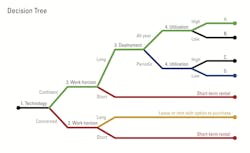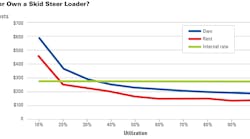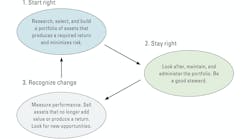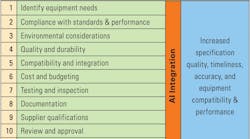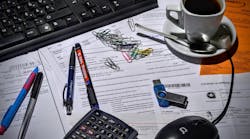What is best: buy, borrow, lease or rent? The question comes up often, and there are no right answers, only intelligent choices. Although cost is certainly important, it is not the overriding consideration. Many other factors and risks must be considered.
Let’s develop some working definitions, and then create a framework that can be used to guide the decision-making process.
Buy. When you buy a machine, you acquire it with your own, or more correctly, your stockholders’ funds. The availability and cost of the “owners’ equity” used to make the purchase depends on the health of the company balance sheet and the owners’ expectations regarding a return on their equity. The owners take the investment risk; there are no fixed, legal or contractual agreements to return the funds invested or produce a return on investment. The asset is yours to use as you wish; you reap both the tax benefits of depreciation and any gain on sale.
Borrow. When you borrow, you use a combination of your own internal funds and funds from an external third-party lender to finance the acquisition of the machine. You enter into a fixed agreement to repay the principal and a given interest on the loan. This makes it a risky form of acquisition, especially when a substantial portion of the investment is financed with external money. The asset is yours to use, depreciate and sell as you wish.
Lease. When you acquire a machine through some form of lease agreement, you actually do not acquire the machine itself. In its most basic form, a lease is an agreement that gives you the right to use a machine for a predefined period under given conditions in exchange for a fixed series of payments to the lessor, who continues to hold title to the asset. The machine is not yours. You use it, pay for it, and return it as stipulated in the lease agreement. There may or may not be provisions that enable you to acquire the asset at given points during the lease.
Rent. When you rent a machine, you acquire the right to use the machine and, in most cases, operate it and maintain it, under clearly defined conditions. Rental payments are fixed and defined, but the normally short rental period is relatively undefined. You certainly never own the asset, and other than fair wear and tear as set out in the agreement, you have no obligations at the end of the rental period.
The working definitions make it clear that buy, borrow, lease or rent are starkly different. The decision as to which to use in a given acquisition situation can have a significant impact on both the cost and the risk of owning and operating a fleet. The following three factors are critical.
Financial considerations
Capital, especially owners’ equity, is an expensive resource. Buying and paying for equipment is one of many competing demands for available funds. Balance sheet considerations and the loan covenants that affect strategic plans must thus come first in any acquisition decision. The balance between the capital employed, the capital required for equipment acquisition, and the capital available, must be clearly understood and all acquisition decisions must be taken within the company’s strategic financial structure.
Cost of acquisition
It is hard to imagine a situation where outright purchase is not the cheapest alternative when internal funds are available and when the cost of owners’ equity is small or neglected. The cost of loans, leases and external rental will definitely include the cost of capital to either the lender, the lessor or the rental house as defined by the capital markets, the risks involved, and the tax benefits gained.
Neglecting the cost of capital in the buy decision means that you believe your own money is free. This is wrong. It is, at the very least, worth the opportunity cost of investing it someplace else. Buy, borrow, lease or rent decisions must take into account the cost of the money used. (continued next page)
Fixed cost recovery risk
There are many risks associated with the equipment acquisition decision. Most of these are associated with utilization and the machine’s ability to recover the fixed costs of ownership. Buy, borrow, lease or rent decisions differ when it comes to the risk of fixed cost recovery, and it is essential to blend decisions in a way that minimizes ownership risk and maximizes benefits available from alternative forms of financing.
The nearby decision tree illustrates the situation.
Four questions work from left to right to produce seven outcomes.
1. How confident are you about the machine, its technology, the manufacturer and the dealer?
2. How confident are you about the work horizon? Do you see long periods of work ahead, or is there a risk that you will only need it for a short period?
3. How confident are you about your ability to deploy the machine year round, year in and year out? Do you believe the machine will stand in the yard periodically?
4. How confident are you about the utilization of the machine once it is deployed? Will it be used a lot or will it work a relatively small number of hours per week or month.
Let’s follow three paths to see how it works.
Look at the green route that ends at outcome A. You are confident in the machine and see a long work horizon. It will be deployed year in and year out, and it will be highly utilized when on site. There is, therefore, little risk of fixed cost recovery. It could be a candidate for a long-term, low-cost fixed price lease or a substantial loan to reduce the equity capital needed.
Now look at the green then blue route that ends at D. You are confident in the machine, and you see a long work horizon. It will, however, stand in the yard a bit, and when on site, it will not be highly utilized. Fixed cost recovery is therefore a significant risk. You should not enter into a firm fixed agreement to make monthly payments on a loan or a lease. It could be a candidate to buy with your own money. You should see it as a long-term asset.
Routes that end at B and C fall between A and D, and indicate a progressive need to reduce fixed cost recovery risk by using less and less outside money.
Third, examine the two short-term rental red lines. There is a risk that you will only need it for a short period. Rent it. Short-tem loans and leases are expensive, your funds have better things to do: Rent it, and return it when done.
Buy, borrow, lease or rent are not similar and internally competitive forms of finance. They are different forms of finance. Apply them each to specific acquisition decisions to manage the risk of fixed cost recovery. Lowering cost is less important than lowering risk.
